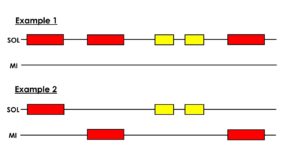
Thank you so much for your responses to the survey we sent out a couple of weeks ago. It came as no big surprise that our number 1 issue was time ~ we all face it on a daily basis! Unfortunately, we can’t change our schedules, but there are ways we can make our classes more efficient. Click HERE and HERE to revisit ideas from past newsletters!
Other issues that popped up were reading pitches and rhythms at the same time, tracking notes, melodic dictation and assessment. Today’s blog will focus on reading pitches and rhythms at the same time and to a certain extent, tracking notes.
As a violinist, when I encounter a passage in a piece of music that is difficult to play, I always tackle the rhythm first. Once I have mastered that, I will tackle the pitches. Then and only then can I begin to put them together slowly. With kids, I follow roughly the same process. First, we look at rhythms and figure them out in Note Knacks. We have lots of practice at this! Then from there we start to add pitches. (Kids will also need a great deal of practice singing sol and mi with a variety of rhythms.)
Here is an excerpt from the new lesson plans that will be coming out next month:
1. Take a 4/4 composition and have students say it rhythmically.
2. Refer to Example 1 in the photo above. Draw 2 lines on your board. Then set up the Note Knacks magnets on the top line and ask students “Are the Note Knacks on the high line or the low one?” (Answer: high). Great! So let’s sing all of the notes on sol”. You can choose to sing sol, sol, sol, sol, sol OR to sing each color on a sol note.
3. Refer to Example 2 in the photo above. Next drop down the 2nd and 4th beats. Say “What do you think happens when I do this?”
(While pointing to the two dropped reds) “That’s right! These two reds are lower than the other notes, so we sing them on a lower pitch. It sounds like this.” Demonstrate for them first and then have them sing it with you. Hopefully they will recognize the pattern from previous lessons.
4. Have kids experiment with placing notes on sol or mi and singing what they create. It helps for kids to play on glocks or xylophones to help them sing the correct pitches.
Simplifying this concept to this point makes it obvious to children that a note possesses both a rhythmic AND pitch aspect to it. The difference between the first example and the second, shows kids that the rhythm doesn’t change. In fact, it is a great question to ask them, “Did the rhythm change from example 1 to the other?”. You could also do the opposite using only 1 pitch. Create a rhythm on sol and then change only the rhythm. Ask kids, “now what changed?”. Students will have fun exploring and discovering new ideas they can incorporate in their future compositions!
Please let us know what you do with your students in the comments below!

0 Comments